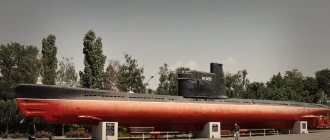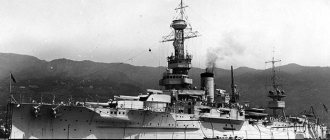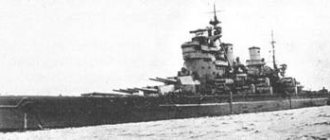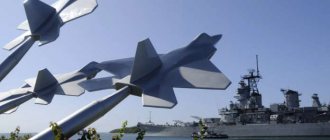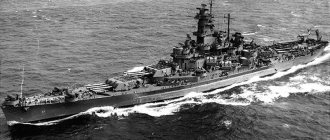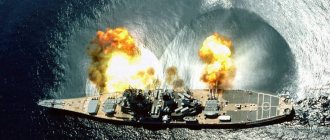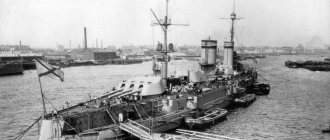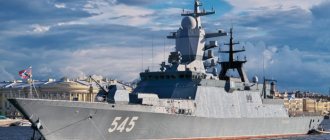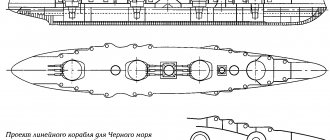Battleships first appeared in the 17th century. For some time they lost the palm to slow-moving battleships. But at the beginning of the 20th century, battleships became the main force of the fleet. The speed and range of artillery pieces became the main advantages in naval battles. Countries concerned about increasing the power of the navy, since the 1930s of the 20th century, began to actively build super-powerful battleships designed to enhance superiority at sea. Not everyone could afford the construction of incredibly expensive ships. The largest battleships in the world - in this article we will talk about super-powerful giant ships.
Richelieu | Length 247.9 m
The ranking of the largest battleships in the world opens with the French giant Richelieu , with a length of 247.9 meters and a displacement of 47 thousand tons. The ship was named in honor of the famous French statesman Cardinal Richelieu. A battleship was built to counter the Italian navy. The battleship Richelieu did not conduct active combat operations, except for participation in the Senegalese operation in 1940. In 1968, the supership was scrapped. One of his guns is installed as a monument in the port of Brest.
Richelieu-class battleships
After the First World War, France found itself in a similar position to Italy regarding the state and further development of the navy.
0
After laying down the “pocket battleships” of the Scharnhorst class in Germany, the French were forced to urgently design ships to combat them. The resulting Dunkirk turned out to be so successful that it served as the basis for the creation of full-fledged battleships of the Richelieu class. The total displacement of the Richelieu was almost 45 thousand tons, and the maximum length was about 250 meters. In order to fit the maximum possible weapons and heavy armor into a limited displacement, the French again used the original layout of the main caliber weapons, tested on the Dunkirk.
0
"Richelieu" carried eight 380-mm guns with a length of 45 calibers in two 4-gun turrets. The weight of the armor-piercing projectile was 890 kg with an initial speed of 830 m/s. This placement made it possible to save the total weight of each gun compared to 3- and especially 2-gun turrets. In addition, only two main-caliber turrets instead of three or four required a shorter length of the main armor belt to protect the guns and artillery magazines, and simplified the system for storing and supplying ammunition and fire control. But such a bold scheme also had its drawbacks. Damage to any of the towers resulted in the failure of half of the ship's artillery, so the French separated each of the towers with an armored partition. Each pair of guns had independent guidance and ammunition supply. In practice, the 2-tower scheme turned out to be unreliable. French sailors used to say that the turret rotation system could fail at any minute. In addition, the aft sector of the ship was not protected by the main caliber guns, which was partly compensated by the large rotation angles of the front turrets.
0
Battleship Jean Bart
The pride of French shipbuilders was armor and protection in general. In terms of survivability, the Richelieu was superior to its competitors from England and Italy, was approximately equal to the larger Bismarck and Iowa, and was second only to the much heavier Yamato. The main armor belt had a thickness of 330 mm and an 18 mm lining. The belt, tilted at 18 degrees, resulted in almost half a meter of armor. The unfinished Jean Bart received about five heavy 406-mm American main-caliber shells. The ship survived this. The Richelieu power plant produced 150 thousand horsepower, and the speed of more than 31 knots was one of the best in the class, formally second only to the Iowa. The maximum cruising range was about 10 thousand miles at an economical speed.
0
In total, the French planned to build three battleships of this type. Only two were put into operation - “Richelieu” and “Jean Bart”, which survived the war not without incident. These ships have become one of the most balanced and successful ships of this class. Many experts give them the palm in battleship construction. They combined fairly powerful weapons, excellent armor and high speed. At the same time, they had average dimensions and displacement. However, many of the positive aspects were only good on paper. Like the Italian battleships, the French Richelieu and Jean Bart did not cover their history with immortal exploits. They managed to survive the war and even serve after it, having undergone modernization.
Bismarck | Length 251 m
The legendary German ship Bismarck ranks 9th among the largest battleships in the world. The length of the vessel is 251 meters, displacement - 51 thousand tons. Bismarck left the shipyard in 1939. German Fuhrer Adolf Hitler was present at its launching. One of the most famous ships of the Second World War was sunk in May 1941 after prolonged fighting by British ships and torpedo bombers in retaliation for the destruction of the British flagship, the cruiser Hood, by a German battleship.
X Conqueror
X Conqueror is the best British battleship, but far from one of the best among its classmates. It has noticeably good stealth and a long-term “cheat” ability “Repair Team”, which solves the issue of poor survivability of the British. But only if you take damage in portions, hiding behind the islands from time to time to straighten yourself out. The disadvantages are low maneuverability and speed, weak air defense and secondary guns.
All high-level British battleships have powerful land mines with high one-time damage, a high chance of penetration and fire, but at the same time the ships of the branch have low accuracy of fire and poor ballistics. Even a cruiser can easily dodge your shells, with some skill, let alone destroyers. As a result, the British line of battleships is very specific and is unlikely to be suitable for beginners.
Tirpitz | Ship 253.6 m
In 8th place on the list of the largest battleships is the German Tirpitz . The length of the vessel was 253.6 meters, displacement - 53 thousand tons. After the death of her “elder brother,” Bismarck, the second of the most powerful German battleships practically did not manage to take part in naval battles. Launched in 1939, the Tirpitz was destroyed in 1944 by torpedo bombers.
Yamato | Length 263 m
Yamato in history ever sunk in a naval battle.
"Yamato" (in translation the name of the ship means the ancient name of the Land of the Rising Sun) was the pride of the Japanese Navy, although due to the fact that the huge ship was taken care of, the attitude of ordinary sailors towards it was ambiguous.
Yamato entered service in 1941. The length of the battleship was 263 meters, displacement - 72 thousand tons. Crew – 2500 people. Until October 1944, Japan's largest ship practically did not participate in battles. In Leyte Gulf, the Yamato opened fire on American ships for the first time. As it turned out later, none of the main calibers hit the target.
The Last March of Japan's Pride
On April 6, 1945, the Yamato set out on its last voyage. American troops landed on Okinawa, and the remnants of the Japanese fleet were given the task of destroying enemy forces and supply ships. The Yamato and the rest of the formation's vessels came under a two-hour attack by 227 American deck ships. Japan's largest battleship went out of action, receiving about 23 hits from aerial bombs and torpedoes. As a result of the explosion of the bow compartment, the ship sank. Of the crew, 269 people survived, 3 thousand sailors died.
X REPUBLIQUE
X République is the best French battleship equipped with two four-barreled artillery turrets. The small number of guns is compensated by fairly fast reloading. The battleship has good accuracy at any distance and a high chance of penetration. The battleship is also quite fast and has the Afterburner ability. The downside is poor survivability. Getting into the focus of enemy ships on this battleship means almost guaranteed to go to the bottom.
French battleships, like American ones, have average ship characteristics. The only advantage is a good secondary gun at high levels. Another branch that beginners should not choose.
If you think that there is a ship missing from this top battleships, write your opinion in the comments.
Musashi | Length 263 m
The largest battleships in the world include the Musashi , with a hull length of 263 meters and a displacement of 72 thousand tons. This is the second giant battleship built by Japan during World War II. The ship entered service in 1942. The fate of "Musashi" turned out to be tragic. The first trip ended with a hole in the bow caused by a torpedo attack by an American submarine. In October 1944, Japan's two largest battleships finally engaged in serious combat. In the Sibuyan Sea they were attacked by American aircraft. By chance, the enemy's main blow was delivered to Musashi. The ship sank after being hit by about 30 torpedoes and aerial bombs. Along with the ship, its captain and more than a thousand crew members died.
On March 4, 2015, 70 years after the sinking, the sunken Musashi was discovered by American millionaire Paul Allen. It is located in the Sibuyan Sea at a depth of one and a half kilometers. Musashi ranks 6th on the list of the largest battleships in the world.
Steel and fire. The best battleships of World War II
By the time the Second World War ended, the class of high-speed battleships had reached the limit in its development, advantageously combining the destructive power and security of dreadnoughts with the high speed of battlecruisers; these examples of naval weapons performed many amazing feats under the flags of all the warring states.
It is not possible to compile any “rating” of battleships of those years - four favorites are vying for first place, and each of them has the most serious reasons for this. As for the rest of the places on the podium, it is generally impossible to make any conscious choice here. Only individual tastes and subjective preferences. Each battleship is distinguished by its unique design, chronicle of combat use and, often, a history of tragic death.
Each of them was created for its own specific tasks and conditions of service, for a specific enemy and in accordance with the chosen concept of using the fleet.
Different theaters of combat dictated different rules: inland seas or open ocean, proximity or, conversely, extreme remoteness of bases. Classic squadron battles with the same monsters or a bloody mess with repelling endless air attacks and shelling of fortifications on the enemy coast.
The ships cannot be considered in isolation from the geopolitical situation, the state of the scientific, industrial and financial spheres of states - all this left a significant imprint on their design.
A direct comparison between any Italian "Littorio" and the American "North Caroline" is completely excluded.
However, the contenders for the title of best battleship are visible to the naked eye. These are the Bismarck, Tirpitz, Iowa and Yamato - ships that even those who have never been interested in the fleet have heard of.
Living according to the teachings of Sun Tzu
...Her Majesty's battleships "Anson" and "Duke of York", aircraft carriers "Victory", "Furious", escort aircraft carriers "Seacher", "Empuere", "Pesuer", "Fancer", cruisers "Belfast", "Bellona" , “Royalist”, “Sheffield”, “Jamaica”, destroyers “Javelin”, “Virago”, “Meteor”, “Swift”, “Vigilant”, “Wakeful”, “Onslot”... - a total of about 20 units under the British , Canadian and Polish flags, as well as 2 naval tankers and 13 carrier-based aviation squadrons.
Only with this composition in April 1944 did the British dare to approach the Altafjord - where, under the gloomy arches of the Norwegian rocks, the pride of the Kriegsmarine, the super-battleship Tirpitz, rusted. The results of Operation Tungsten are assessed as controversial - carrier-based aircraft managed to bomb a German base and cause serious damage to the battleship's superstructure. However, another Pearl Harbor did not work out - the British were unable to inflict mortal wounds on the Tirpitz.
The Germans lost 123 men killed, but the battleship still posed a threat to shipping in the North Atlantic. The main problems were caused not so much by numerous bomb hits and fires on the upper deck, but by newly discovered leaks in the underwater part of the hull - the result of a previous British attack using mini-submarines.
...In total, during its stay in Norwegian waters, the Tirpitz withstood dozens of air strikes - in total, during the war years, about 700 aircraft of British and Soviet aviation took part in raids on the battleship! In vain.
Hidden behind an anti-torpedo net, the ship was invulnerable to Allied torpedo weapons. At the same time, aerial bombs turned out to be ineffective against such a well-protected target; it was possible to destroy the armored citadel of the battleship for an infinitely long time, but the destruction of the superstructures could not critically affect the combat effectiveness of the Tirpitz.
Meanwhile, the Britons stubbornly rushed to the site of the Teutonic beast: mini-submarines and human torpedoes; raids by carrier-based and strategic aviation. Local informant agents, regular air surveillance of the base...
“Tirpitz” became a unique embodiment of the ideas of the ancient Chinese commander and thinker Sun Tzu (“The Art of War”) - without firing a single shot at enemy ships, it shackled all British actions in the North Atlantic for three years!
One of the most effective warships of the Second World War, the invincible Tirpitz turned into an ominous scarecrow for the British Admiralty: planning for any operation began with the question “What to do if the Tirpitz leaves its mooring and goes to sea?
It was the Tirpitz that scared away the escort of convoy PQ-17. He was hunted by all the battleships and aircraft carriers of the metropolitan fleet in the Arctic latitudes. The K-21 boat shot at him. For his sake, Lancasters from the Royal Air Force settled at the Yagodny airfield near Arkhangelsk. But everything turned out to be useless. The British were able to destroy the super-battleship only towards the end of the war with the help of monstrous 5-ton Tallboy bombs.
Tallboy
The impressive success of the battleship Tirpitz is a legacy left from the legendary Bismarck, a sister battleship, the encounter with which forever instilled fear in the hearts of the British: the funeral pillar of flame soared above the British battlecruiser HMS Hood froze before our eyes. During the battle in the Denmark Strait, the gloomy Teutonic knight needed only five volleys to deal with the British “gentleman”.
"Bismarck" and "Prinz Eugen" on a military campaign
And then came the hour of reckoning. The Bismarck was chased by a squadron of 47 ships and 6 submarines of Her Majesty. After the battle, the British calculated: in order to sink the beast, they had to fire 8 torpedoes and 2876 shells of main, medium and universal caliber!
What a tough guy!
Hieroglyph "loyalty". Yamato-class battleships
There are three useless things in the world: the Cheops pyramid, the Great Wall of China and the battleship Yamato...Really?
This is what happened to the battleships Yamato and Musashi: they were undeservedly slandered. Around them there was a persistent image of “losers”, useless “Venderwaffles” who died shamefully at the first meeting with the enemy.
But based on the facts, we have the following:
The ships were designed and built on time, managed to fight and, finally, suffered a heroic death in the face of numerically superior enemy forces.
What else is required of them?
Bright victories? Alas, in the situation in which Japan was in the period 1944-45, even the sea king Poseidon himself could hardly have acted better than the battleships Musashi and Yamato.
Disadvantages of super battleships?
Yes, first of all, weak air defense - neither the monstrous Sansiki 3 fireworks (460 mm anti-aircraft shells), nor hundreds of small-caliber magazine-fed machine guns could replace modern anti-aircraft guns and control systems with fire adjustment based on radar data.
Weak PTZ? I am begging you! "Musashi" and "Yamato" died after 10-11 torpedo hits - not a single battleship on the planet could withstand that many (for comparison, the probability of the death of the American "Iowa" from being hit by six torpedoes, according to the calculations of the Americans themselves, was estimated at 90%) .
Otherwise, the battleship Yamato corresponded to the phrase “the most, the most”
The largest battleship in history and, concurrently, the largest warship that took part in the Second World War. 70 thousand tons of total displacement. The main caliber is 460 mm. Armored belt – 40 centimeters of solid metal. The walls of the conning tower are half a meter of armor. The thickness of the front part of the main battery turret is even greater - 65 centimeters of steel protection.
A grandiose spectacle!
The main miscalculation of the Japanese was the veil of extreme secrecy that shrouded everything related to the Yamato-class battleships. To date, only a few photographs of these monsters exist - mostly taken from American aircraft.
But in vain!
Such ships were worth being proud of and seriously frightening the enemy with them - after all, until the last moment the Yankees were sure that they were dealing with ordinary battleships, with guns of 406 mm caliber.
With a competent PR policy, the very news of the existence of the battleships Yamato and Musashi could cause panic among the commanders of the US Navy and their allies - just as happened with the Tirpitz. The Yankees would rush to build similar ships with half-meter armor and 460 or even 508 mm guns - in general, it would be fun. The strategic effect of Japanese super-battleships could be much greater.
Yamato Museum in Kure. The Japanese carefully preserve the memory of their “Varyag”
How did the leviathans die?
The Musashi sailed all day in the Sibuyan Sea under heavy attacks from aircraft from five American aircraft carriers. He sailed all day, and by the evening he died, receiving, according to various estimates, 11-19 torpedoes and 10-17 aerial bombs... Do you think the Japanese battleship had great security and combat stability? And which of his peers could repeat this?
"Yamato"...death from above was his destiny. Traces of torpedoes, the sky black with planes... Frankly speaking, Yamato committed honorable seppuku, going out as part of a small squadron against eight aircraft carriers of the 58th task force. The result is predictable - two hundred aircraft tore apart the battleship and its small escort in two hours.
The era of high technology. Iowa-class battleships
What if? What if, instead of the Yamato, a battleship identical to the American Iowa came out to meet Admiral Mitscher’s 58th task force? What if Japanese industry had been able to create air defense systems similar to those found on US Navy ships at the time?
How would the battle between the battleship and American aircraft carriers have ended if the Japanese sailors had systems similar to the Mk.37, Ford Mk.I Gunfire Control Computer, SK, SK-2, SP, SR, Mk.14, Mk.51, Mk.53 ... ?
Behind the dry indices are hidden masterpieces of technical progress - analog computers and automatic fire control systems, radars, radio altimeters and projectiles with a radar fuse - thanks to all these “chips,” the Iowa anti-aircraft fire was at least five times more accurate and effective than the shots of Japanese anti-aircraft gunners .
And if you take into account the terrifying rate of fire of the Mk.12 anti-aircraft guns, the extremely effective 40 mm Bofors and belt-fed Oerlikon assault rifles... There is a considerable chance that the American air attack could have drowned in blood, and the damaged neo-Yamato could have hobbled to Okinawa and run aground, turning into an invincible artillery battery (according to the Ten-Ichi-Go operation plan).
Everything could have been... alas, the Yamato went to the seabed, and the impressive complex of anti-aircraft weapons became the prerogative of the American Iowas.
It is absolutely impossible to come to terms with the idea that the Americans have the best ship again. US haters will quickly find a dozen reasons why the Iowa cannot be considered the most advanced battleship.
The Iowas are harshly criticized for the lack of a medium caliber (150...155 mm) - unlike any German, Japanese, French or Italian battleships, American ships were forced to fend off attacks from enemy destroyers only with universal anti-aircraft guns (5 inches, 127 mm).
Also, among the disadvantages of the Iowas are the lack of reloading compartments in the main battery towers, worse seaworthiness and “wave surfing” (compared to the same British Vanguard), the relative weakness of their PTZ compared to the Japanese “long lances”, “fraud” with declared maximum speed (at a measured mile, the battleships barely accelerated to 31 knots - instead of the declared 33!).
But perhaps the most serious of all accusations is the weakness of the armor compared to any of their peers - the Iowa's beam bulkheads especially raise many questions.
Of course, defenders of American shipbuilding will now go into overdrive, proving that all of the Iowa’s listed shortcomings are just an illusion; the ship was designed for a specific situation and ideally suited the conditions of the Pacific Theater of Operations.
The lack of a medium caliber became an advantage of American battleships: universal “five-inch” guns were enough to fight surface and air targets; there was no point in taking 150 mm guns on board as “ballast.” And the presence of “advanced” fire control systems completely eliminated the factor of the lack of “medium caliber”.
Accusations of poor seaworthiness are a purely subjective opinion: the Iowa has always been considered an extremely stable artillery platform. As for the strong “overwhelming” of the bow of a battleship in stormy weather, this myth was born in our time. More modern sailors were surprised by the habits of the armored monster: instead of calmly rocking on the waves, the heavy Iowa cut the waves like a knife.
The increased wear of the main battery barrels is explained by very heavy projectiles (which is not bad) - the Mk.8 armor-piercing projectile weighing 1225 kg was the heaviest ammunition of its caliber in the world.
The Iowa had no problems at all with the range of shells: the ship had a whole range of armor-piercing and high-explosive ammunition and charges of varying power; after the war, “cassette” Mk.144 and Mk.146 appeared, filled with explosive grenades in quantities of 400 and, accordingly, 666 pieces. A little later, the Mk.23 special ammunition with a 1 kt nuclear warhead was developed.
As for the “shortage” of the design speed at the measured mile, the tests of the Iowas were carried out with limited power of the power plant - just like that, without a good reason, to boost the vehicles to the design 254,000 hp. the thrifty Yankees refused.
The general impression of the Iowas can only be spoiled by their relatively low security... however, this disadvantage is more than compensated for by the many other advantages of the battleship.
The Iowas have more service than all other WWII battleships combined - World War II, Korea, Vietnam, Lebanon, Iraq... Battleships of this type outlived everyone - modernization in the mid-1980s made it possible to extend the service life of veterans until the beginning of the 21st century - the battleships lost parts artillery weapons, in return receiving 32 Tomahawk SLCMs, 16 Harpoon anti-ship missiles, SeaSparrow air defense systems, modern radars and Phalanx close combat systems.
Off the coast of Iraq
However, the physical wear and tear of the mechanisms and the end of the Cold War played an important role in the fate of the most famous American battleships - all four monsters left the US Navy ahead of schedule and turned into large naval museums.
Well, the favorites have been identified. Now is the time to mention a number of other armored monsters - after all, each of them is worthy of its own portion of surprise and admiration.
For example, Jean Bart is one of two Richelieu-class battleships built. An elegant French ship with a unique silhouette: two four-gun turrets in the bow, a stylish superstructure, a dashingly curved back chimney...
Richelieu-class battleships are considered one of the most advanced ships in their class: having a displacement of 5-10 thousand tons less than any Bismarck or Littorio, the “French” were practically not inferior to them in terms of armament power, and in terms of “ security" - the design and thickness of the Richelieu's armor was even better than many of its larger peers. And all this was successfully combined with a speed of more than 30 knots - the “French” was the fastest of the European battleships!
The unusual fate of these battleships: the flight of unfinished ships from the shipyard to avoid capture by the Germans, a naval battle with the British and American fleets in Casablanca and Dakar, repairs in the USA, and then a long happy service under the flag of France until the second half of the 1960s.
But here is a magnificent trio from the Apennine Peninsula - Italian battleships of the Littorio class.
These ships are usually the object of harsh criticism, but if you take an integrated approach to assessing them, it turns out that the Littorio battleships are not so bad compared to their British or German peers, as is commonly believed.
The project was based on the ingenious concept of the Italian fleet - to hell with greater autonomy and fuel reserves! – Italy is located in the middle of the Mediterranean Sea, all bases are nearby. The saved load reserve was spent on armor and weapons. As a result, the Littorio had 9 main caliber guns in three rotating turrets - more than any of their European counterparts.
"Roma"
A noble silhouette, high-quality lines, good seaworthiness and high speed are in the best traditions of the Italian school of shipbuilding.
Ingenious anti-torpedo protection based on calculations by Umberto Pugliese.
At a minimum, the staggered reservation scheme deserves attention. In general, when it comes to armor, Littorio-class battleships deserve the highest marks.
As for the rest... As for the rest, the Italian battleships turned out to be bad - it is still a mystery why the Italians’ guns fired so crookedly - despite excellent armor penetration, the 15-inch Italian shells had surprisingly low accuracy and accuracy of fire. Rebooting gun barrels? The quality of the liners and shells? Or maybe the national characteristics of the Italian character had an impact?
In any case, the main problem of the Littorio-class battleships was their incompetent use. The Italian sailors never managed to engage in a general battle with Her Majesty's fleet. Instead, the lead “Littorio” was sunk right at its anchorage during a British raid on the Taranto naval base (the cheerful slobs were too lazy to pull up the anti-torpedo net).
The Vittorio Veneto raid against British convoys in the Mediterranean ended no better - the battered ship was barely able to return to base.
In general, nothing good came out of the idea with the Italian battleships. The battleship Roma ended its combat journey brighter and more tragically than anyone else, disappearing in a deafening explosion of its own artillery magazines - the result of a well-aimed hit by a German guided air bomb "Fritz-X" (air bombs? That's an understatement. The 1,360-kilogram Fritz-X ammunition was little like regular bomb).
Epilogue.
There were different battleships. Some of them were formidable and effective. There were no less formidable ones, but ineffective ones. But every time, the fact that the enemy had such ships caused the opposite side a lot of trouble and anxiety. Battleships always remain battleships. Powerful and destructive ships with the highest combat stability.
Based on materials from: https://wunderwaffe.narod.ru/ https://korabley.net/ https://www.navy.mil.nz/ https://navycollection.narod.ru/ https://www.wikipedia .org/ https://navsource.org/
Soviet Union | Length 269 m
Incredibly, the Soviet Union never built a single super battleship. In 1938, the battleship " Soviet Union " was laid down. The length of the ship was supposed to be 269 meters, and the displacement was 65 thousand tons. By the beginning of the Great Patriotic War, the battleship was 19% completed. It was never possible to complete the ship, which could have become one of the largest battleships in the world.
X YAMATO
X Yamato is the best Japanese battleship, which has the most powerful artillery in the game, 460 mm. All Japanese battleships, including this one, have powerful armor-piercing shells. Not a single ship from another branch can boast of this. Yamato also has good protection against torpedoes. Among the disadvantages of this battleship, it is worth noting the short duration of the “Repair Team” - only 10 seconds. In other respects, Japanese battleships have average performance and are fairly versatile ships.
Wisconsin | Length 270 m
The American battleship Wisconsin is ranked 4th in the ranking of the largest battleships in the world. It was 270 meters long and had a displacement of 55 thousand tons. It went into operation in 1944. During World War II, he accompanied aircraft carrier groups and supported landing operations. Was deployed during the Gulf War. Wisconsin is one of the last battleships in the US Navy Reserve. Was decommissioned in 2006. The ship is now docked in Norfolk.
Comparison table of differences
To understand how naval combat units differ from each other, it is worth studying the table that shows their main characteristics and purpose.
| Combat unit | Displacement | Speed | Tasks |
| Corvette | From 1200 to 1500 tons | 30 to 40 km/h | Anti-submarine defense of a convoy or coastal facility |
| Destroyer | From 3000 to 10,000 tons | About 60 km/h | Escorting and protecting a convoy from short-range attacks |
| Frigate | Up to 4000 tons | From 55 to 60 km/h | Search and destruction of enemy submarines, missile defense and air defense of ships |
| Cruiser | About 10,000 tons | Up to 60 km/h | Defense of combat formations and convoys, destruction of enemy light forces |
| Battleship | From 20,000 to 80,000 tons | 20 to 25 km/h | Destruction of enemy ships, artillery support for ground operations |
| Aircraft carrier | From 30,000 to 100,000 tons | From 45 to 55 km/h | Protecting naval units, supporting ground operations, destroying enemy air defenses |
Iowa | Length 270 m
The American battleship Iowa , with a length of 270 meters and a displacement of 58 thousand tons, ranks 3rd in the ranking of the largest battleships in the world. The ship entered service in 1943. During World War II, Iowa actively participated in combat operations. In 2012, the battleship was withdrawn from the fleet. Now the ship is in the port of Los Angeles as a museum.
New Jersey | Length 270.53 m
Second place in the ranking of the largest battleships in the world is occupied by the American ship New Jersey , or Black Dragon. Its length is 270.53 meters. Refers to the Iowa-class battleships. Left the shipyard in 1942. The New Jersey is a true veteran of naval battles and the only ship that took part in the Vietnam War. Here he performed the role of supporting the army. After 21 years of service, it was withdrawn from the fleet in 1991 and received museum status. Now the ship is parked in the city of Camden.
Speaking of the Watermelon project.
In general, the project repeated the “Flower” sketch - 16 guns in a 4 * 4 pattern. Same concept: guns + bigger size = better defense.
There was some kind of system in the fact that Russian battleships received such “strange names”. In principle, visible - “Peas”, “Corn”, “Grapes” - many parts, many tools. “Watermelon”, “Melon”, “Eggplant”, “Pumpkin” - there are fewer weapons, but they are more powerful. “Nut”, “Coconut”, “Potato”, “Fern” - barriers. “Solnyshko”, “Sunflower”, “Romashka”, “Kuvshinka” are support ships. The emperor himself did not talk about such a system, but some could have guessed what was being said. Moreover, the emperor himself made reservations “Dave”, “zombie”, “lawn”, backyard”, “ice pea shooter... Maybe shoot with liquid nitrogen?” The final touch was the anthem of the “zoological garden” - light music performed on the piano.
*** After the hymn to the “zoological garden”, Emperor Nicholas 2 took up music. At first everything was peaceful - “Combat”, “Come on Russia”, “Guys from our yard”. But after “the nuclear landmine flies and swings,” the emperor suddenly gave all the songs that he saw in the future the character of secret ones. Then, within 24 hours, a “headhunt” order was issued—various scientists and specialists began to be lured to Russia.
*** This is the end of the trilogy. Yes, a lot more could have been written, but nothing has been written. Yes, there were thoughts that the victim would wonder whether he was going the right way (in terms of armor on battleships... or rather, the lack of it). There was also the option of introducing new lattice armor... But no favors. If a person is actively using the latest knowledge, then only the latest knowledge should be used.
